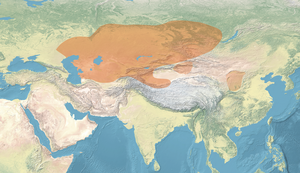  khovoSha- jingSubeshiSlab-grave cultureDONGHUSABEANSOrdos culturePazyrykTagarChandmanSaglyJINDian cultureMACEDONIAN EMPIRENANDA EMPIREZHOU DYNASTYMEROËScythiansSauro- matiansMassagetaeDahaeThe Korgantas culture within the Saka realm ( ), and contemporary Asian polities c. -325. | |
| Geographical range | South Central Siberia |
|---|---|
| Period | Iron Age |
| Dates | ca. 400–113 BCE |
| Preceded by | Tasmola culture |
| Followed by | Xiongnu Empire |
The Korgantas culture (c. 400-113 BCE) replaced the Tasmola culture in Central Kazakhstan. It is used sometimes termed as the "Korgantas period" of the Tasmola culture.
The tombs of the Korgantas period differ significantly from those of the earlier Tasmola, lacking dromos passageways, and being smaller, with animal sacrifices arranged near the head. The burials are often covered with a chaotic assemblage of stones, and the dead were oriented to the East or the Northeast. Many characteristics of these burials, especially the heads of sacrificed animals, are similar to those of early Hunnic burials. In a recent study, various Korgantas period graves were carbon-dated to between 400 and circa 100 BCE cal.
Genetically, the Korgantas period seems to mark an influx of Ancient Northeast Asians (Devils_Cave_N profile) in Central Asia. Of four Korgantas individuals analysed in a recent study, three had about 50% Ancient Northeast Asians (Devils_Cave_N) ancestry combined with about 50% Central Saka ancestry (Tasmola_Pazyryk), while only one had a traditional Central Saka profile. The Korgantas people may have resulted from immigrations from the eastern regions of Central Asia, and may have come from the Ordos region of northern China.
The end of the Korgantas period is marked by the expansion of the Xiongnu. The Korgantas period is sometimes presented as the "later Korgantas phase of the early Hun period".
References
- Ivanov, Sergei Sergeevich (2023). "Asia, Steppe, East: Early Iron Age Pastoralist Cultures". Reference Module in Social Sciences: Fig.1. doi:10.1016/B978-0-323-90799-6.00253-6. ISBN 978-0-443-15785-1.
- Gnecchi-Ruscone et al. 2021, "Korgantas culture that replaced the Tasmola in central Kazakhstan.".
- ^ Chang, Claudia (16 August 2017). Rethinking Prehistoric Central Asia: Shepherds, Farmers, and Nomads. Routledge. p. 52. ISBN 978-1-351-70158-7.
Korgantas phase dates between 397 and 113 BC cal BC (2 sigma). These burials lack the dromos passageway of Tasmola burials, are usually smaller in size...
- ^ Beisenov et al. 2016.
- Gnecchi-Ruscone et al. 2021, Fitting models for the main IA groups using LBA sources, the major genetic shift with the “new” East Asian influx (DevilsCave_N-like) observed in the Middle IA outliers and Korgantas. (...) From the second half of the first millennium BCE, we detect a major genetic shift in a number of outliers that are interestingly linked with the emergence of the Korgantas culture that replaced the Tasmola in central Kazakhstan..
- Gnecchi-Ruscone et al. 2021.
- Beisenov et al. 2016, "Specific features of burial structures and artifacts (Figure 3) suggest that the Korgantas are related to sites in the eastern regions of Central Asia, and that the population might have migrated from Ordos region of north China (Tairov 2006; Shulga 2011).".
Sources
- Gnecchi-Ruscone, Guido Alberto; Khussainova, Elmira; Kahbatkyzy, Nurzhibek; Musralina, Lyazzat; Spyrou, Maria A.; Bianco, Raffaela A.; Radzeviciute, Rita; Martins, Nuno Filipe Gomes; Freund, Caecilia; Iksan, Olzhas; Garshin, Alexander; Zhaniyazov, Zhassulan; Bekmanov, Bakhytzhan; Kitov, Egor; Samashev, Zainolla; Beisenov, Arman; Berezina, Natalia; Berezin, Yakov; Bíró, András Zsolt; Évinger, Sándor; Bissembaev, Arman; Akhatov, Gaziz; Mamedov, Aslan; Onggaruly, Akhan; Voyakin, Dmitriy; Chotbayev, Aidos; Kariyev, Yeldos; Buzhilova, Alexandra; Djansugurova, Leyla; Jeong, Choongwon; Krause, Johannes (26 March 2021). "Ancient genomic time transect from the Central Asian Steppe unravels the history of the Scythians". Science Advances. 7 (13): eabe4414. Bibcode:2021SciA....7.4414G. doi:10.1126/sciadv.abe4414. ISSN 2375-2548. PMC 7997506. PMID 33771866.
- Beisenov, Arman Z; Svyatko, Svetlana V; Kassenalin, Aibar Е; Zhambulatov, Kairat А; Duisenbai, Daniyar; Reimer, Paula J (March 2016). "First Radiocarbon Chronology for the Early Iron Age Sites of Central Kazakhstan (Tasmola Culture and Korgantas Period)" (PDF). Radiocarbon. 58 (1): 179–191. Bibcode:2016Radcb..58..179B. doi:10.1017/RDC.2015.18. S2CID 130995035.